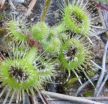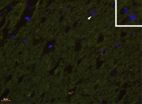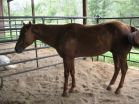(Press-News.org) Swift predators are common in the animal world but are rare in the plant kingdom. New research shows that Drosera glanduligera, a small sundew from southern Australia, deploys one of the fastest and most spectacular trapping mechanisms known among carnivorous plants.
The study, published Sep. 26 in the open access journal PLOS ONE, is a collaboration between the Plant Biomechanics Group at the University of Freiburg and private sundew cultivators from Weil am Rhein, and provides the first experimental demonstration of fast-moving snap tentacles in sundew plants propelling prey into the plant's leaf trap, where they are captured and digested. The authors also provide a biophysical explanation for the quick motion of these touch-sensitive tentacles.
Glue-covered tentacles and leaf traps in sundew species work like flypaper to trap insects, but this is the first study to show how fast-acting 'snap' tentacles are involved in prey capture. The researchers found that insects walking on the snap tentacles trigger a touch-sensitive catapult action, propelling prey onto the nearby glue tentacles. Glue tentacles then gradually move the prey down to the leaf trap for digestion and assimilation.
VIDEO:
This image shows how snap tentacles capture an insect.
Click here for more information.
The authors suggest that these catapulting snap tentacles could help increase the reach of a leaf trap beyond just the glue tentacles, and perhaps allow the plant to capture larger insects that may be strong enough to struggle free of the glue tentacles alone. Catapulting prey towards the center of the plant could also improve digestion of the insect and prevent theft of the captured prey by other predators.
"Such plants are of particular interest to plant biologists because of their sophisticated and complex structural and mechanical adaptations to carnivory", says Thomas Speck, lead author on the study.
INFORMATION:
Citation: Poppinga S, Hartmeyer SRH, Seidel R, Masselter T, Hartmeyer I, et al. (2012) Catapulting Tentacles in a Sticky Carnivorous Plant. PLoS ONE 7(9): e45735.
doi:10.1371/journal.pone.0045735
Financial Disclosure: This work was supported by the German Federal Ministry of Education and Research within the funding directive BIONA. http://www.bmbf.de/en/index.php. http://www.bionische-innovationen.de/#home.html. The funders had no role in study design, data collection and analysis, decision to publish, or preparation of the manuscript.
Competing Interest Statement: The authors have declared that no competing interests exist.
PLEASE LINK TO THE SCIENTIFIC ARTICLE IN ONLINE VERSIONS OF YOUR REPORT (URL goes live after the embargo ends):
http://dx.plos.org/10.1371/journal.pone.0045735
Touch-sensitive tentacles catapult prey into carnivorous plant traps
Fast-moving one-shot tentacles propel insects into sundew trap leaves
2012-09-27
ELSE PRESS RELEASES FROM THIS DATE:
Large 2012 earthquake triggered temblors worldwide for nearly a week
2012-09-27
This year's largest earthquake, a magnitude 8.6 temblor on April 11 centered in the East Indian Ocean off Sumatra, did little damage, but it triggered quakes around the world for at least a week, according to a new analysis by seismologists from the University of California, Berkeley, and the U.S. Geological Survey (USGS).
The April 11 quake was unusually large – the tenth largest in the last 100 years and, similar to a few other recent large quakes, triggered small quakes during the three hours it took for seismic waves to travel through Earth's crust.
The new study ...
Cannabis withdrawal symptoms might have clinical importance
2012-09-27
Cannabis users have a greater chance of relapse to cannabis use when they experience certain withdrawal symptoms, according to research published Sep. 26 in the open access journal PLOS ONE led by David Allsop of the National Cannabis Prevention and Information Centre (NCPIC) at the University of New South Wales.
The authors tested a group of dependent cannabis users over a two week period of abstinence for impairment related to their withdrawal symptoms. Findings were correlated with the probability of relapse to cannabis use during the abstinence period, and the level ...
First evidence of fetal DNA persisting in human brain tissue
2012-09-27
Small portions of male DNA, most likely left over in a mother's body by a male fetus can be detected in the maternal brain relatively frequently, according to a report published Sep. 26 in the open access journal PLOS ONE by William Chan of Fred Hutchinson Cancer Research Center and his colleagues.
The process, called fetal 'microchimerism (Mc)', is common in other tissues such as blood, but this is the first evidence of male Mc in the human female brain. Microchimerism can be both beneficial and harmful to maternal health, since it is associated with processes such ...
Viewing gender-specific objects influences perception of gender identity
2012-09-27
Spending too much time looking at high heels may influence how a viewer perceives the gender of an androgynous face, according to new research published Sep. 26 in the open access journal PLOS ONE by Amir Homayoun Javadi of Technische Universität, Dresden and his colleagues. The study sheds new light on how the objects surrounding us may influence our perceptions of gender.
The authors found that when people view objects highly associated with one gender, like high heels for women or electric shavers for men, for a short period of time and are then asked to identify the ...
Psychology of equine performance and the biology behind laminitis
2012-09-27
Achieving the best performance from a horse is the goal of not just professional riders, but also the millions of amateur and hobby riders all over the world. A new article published in BioMed Central's open access journal BMC Veterinary Research looks at the issues surrounding training, competition environment and practices, and how the psychology of horse mood, emotion and temperament can be used to enhance performance. A sister article looks at the devastating disease laminitis, and finds that the anti-inflammatory protein apolipoprotein A-IV (APOA-IV) is raised in chronic ...
Scientists make old muscles young again in attempt to combat aging
2012-09-27
An international team of scientists have identified for the first time a key factor responsible for declining muscle repair during ageing, and discovered how to halt the process in mice with a common drug. Although an early study, the findings provide clues as to how muscles lose mass with age, which can result in weakness that affects mobility and may cause falls.
The study, to be published in the journal Nature, involved researchers from King's College London, Harvard University and Massachusetts General Hospital.
The study looked at stem cells found inside muscle ...
TB drug could reduce mortality for MDR-TB and XDR-TB cases
2012-09-27
Results from an observational study evaluating a new anti-TB drug have found that the treatment can improve outcomes and reduce mortality among patients with both MDR-TB and XDR-TB.
The research, published online ahead of print today (27 September 2012) in the European Respiratory Journal, suggests a drug called delamanid could have a public health benefit for MDR-TB and also for XDR-TB, as few effective treatment options are currently available.
Over the past two decades, multidrug-resistant TB (MDR-TB) has emerged as a significant public health threat, with strains ...
Salt marsh carbon may play role in slowing climate warming, study shows
2012-09-27
A warming climate and rising seas will enable salt marshes to more rapidly capture and remove carbon dioxide from the atmosphere, possibly playing a role in slowing the rate of climate change, according to a new study led by a University of Virginia environmental scientist and published in the Sept. 27 issue of the journal Nature.
Carbon dioxide is the predominant so-called "greenhouse gas" that acts as sort of an atmospheric blanket, trapping the Earth's heat. Over time, an abundance of carbon dioxide can change the global climate, according to generally accepted scientific ...
WSU study finds dioxin causes disease and reproductive problems across generations
2012-09-27
PULLMAN, Wash.—Since the 1960s, when the defoliant Agent Orange was widely used in Vietnam, military, industry and environmental groups have debated the toxicity of its main ingredient, the chemical dioxin, and how it should be regulated.
But even if all the dioxin were eliminated from the planet, Washington State University researchers say its legacy will live on in the way it turns genes on and off in the descendants of people exposed over the past half century.
Writing in the journal PLoS ONE, biologist Michael Skinner and members of his lab say dioxin administered ...
Inadequate cellular rest may explain effects of aging on muscles
2012-09-27
Is aging inevitable? What factors make older tissues in the human body less able to maintain and repair themselves, as in the weakening and shrinkage of aging muscles in humans? A new study from Massachusetts General Hospital (MGH) investigators and collaborators at King's College London describes the mechanism behind impaired muscle repair during aging and a strategy that may help rejuvenate aging tissue by manipulating the environment in which muscle stem cells reside. The report will appear in the journal Nature and has received advance online release.
Rare muscle ...
LAST 30 PRESS RELEASES:
High Mountain Asia’s shrinking glaciers linked to monsoon changes
All DRII-ed up: How do plants recover after drought?
Research on stigma says to just ‘shake it off’
Scientists track lightning “pollution” in real time using NASA satellite
Millions of women rely on contraceptives, but new Rice study shows they may do more than just prevent pregnancy
Hot days make for icy weather, Philippine study finds
Roxana Mehran, MD, receives the most prestigious award given by the European Society of Cardiology
World's first clinical trial showing lubiprostone aids kidney function
Capturing language change through the genes
Public trust in elections increases with clear facts
Thawing permafrost raised carbon dioxide levels after the last ice age
New DNA test reveals plants’ hidden climate role
Retinitis pigmentosa mouse models reflect pathobiology of human RP59
Cell’s ‘antenna’ could be key to curing diseases
Tiny ocean partnership between algae and bacteria reveals secrets of evolution
Scientists uncover cellular “toolkit” to reprogram immune cells for cancer therapy
Blocking protein control pathway slows rhabdomyosarcoma growth in mice
2026 Hertz Fellowship Application Now Open
The gut immune system is altered in mouse model of Alzheimer’s, providing a new target for therapeutics
ADHD drugs are being prescribed too quickly to preschoolers
UCLA scientists develop off-the-shelf immunotherapy for metastatic kidney cancer
Extreme heat linked to spike in domestic violence calls in New Orleans, study finds
Mount Sinai-Duke University study identifies DNA variants that increase testosterone production in PCOS patients
Physiology-guided complete revascularization in older patients with myocardial infarction
Metals and sulfate in air pollution mixture may contribute most to asthma hospitalizations
Understanding the profound yet hidden effects of neglect on white matter structures
SEOULTECH researchers develop revolutionary 3D-printed smart materials create high-performance pressure sensors for wearables
Pusan National University scientists develop self-deploying material for next-gen robotics
Remote screening for asymptomatic atrial fibrillation
Inflammation may explain why women with no standard modifiable risk factors have heart attacks and strokes
[Press-News.org] Touch-sensitive tentacles catapult prey into carnivorous plant trapsFast-moving one-shot tentacles propel insects into sundew trap leaves




